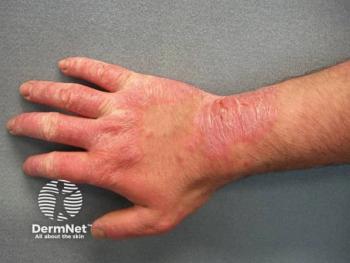
Journal Digest: May 21
Key Takeaways
- Self-reported hand eczema severity moderately correlates with clinical assessments; no single tool is universally recommended.
- Chronic hand eczema patients use more analgesics, especially paracetamol and NSAIDs, than controls.
This review of the latest dermatologic studies includes insights into chronic hand eczema, including self-reported severity, burden of pain and use of analgesics, and more.
Contact Dermatitis: Self-Reported Severity of Hand Eczema: Important Outcome but How Can We Measure It?
A study examined the validity of self-reported instruments for assessing hand eczema severity, comparing them to clinical gold standards like the Hand Eczema Severity Index (HECSI) and Osnabrück Hand Eczema Severity Index. The research explored various self-reporting tools, including complex instruments and global rating scales. The findings showed moderate correlations between these self-report methods and clinical assessments, with the patient-HECSI demonstrating the strongest correlation. However, the study concluded that no single instrument could be universally recommended, and the choice of tool depends on the context and study goals.1
Contact Dermatitis: Burden of Pain and Use of Analgesics in Patients With Chronic Hand Eczema-Findings From the Danish Skin Cohort
A study from the Danish Skin Cohort examined analgesic use among patients with chronic hand eczema compared to a control group. The research included 1,032 patients and 11,166 controls, finding that patients with chronic hand eczema used more analgesics, with paracetamol being the most frequently used (35.3% vs. 25.7%) followed by NSAIDs (21.5% vs. 15.3%). The use of analgesics was notably higher in those with moderate to severe chronic hand eczema.2
Journal of the European Academy of Dermatology and Venereology: Consensus on core domains for hand eczema trials: Signs, symptoms, control and quality of life
An international study aimed to establish a core outcome set for therapeutic hand eczema trials. Through a 2-round online Delphi survey and a hybrid consensus meeting, 208 stakeholders from various backgrounds, including physicians, patients, researchers, and industry representatives, participated. The consensus was reached on 4 key core domains: ‘signs of hand eczema,’ ‘symptoms of hand eczema,’ ‘hand eczema-related quality of life,’ and ‘hand eczema control over time,’ with each domain including specific subdomains. Domains such as ‘skin barrier function’ and ‘patient-reported treatment experience,’ along with many subdomains, were excluded. The results highlight the importance of measuring the signs and symptoms of hand eczema, quality of life, and control over time in all future hand eczema therapeutic trials to improve comparability and evidence-based decision-making.3
Lancet: Efficacy and safety of topical delgocitinib cream versus oral alitretinoin capsules in adults with severe chronic hand eczema (DELTA FORCE): a 24-week, randomised, head-to-head, phase 3 trial
The DELTA FORCE phase 3 trial evaluated the efficacy and safety of delgocitinib cream versus oral alitretinoin in adults with severe chronic hand eczema. The trial demonstrated that delgocitinib cream significantly outperformed alitretinoin in improving HECSI scores after 12 weeks (–67.6 vs. –51.5; p<0.0001). Additionally, delgocitinib had a more favorable safety profile, with fewer patients reporting adverse events (49% vs. 76%), particularly fewer incidences of headache and nausea.4
Dermatitis: Differences in Clinical Characteristics Between Hand Eczema and Hand Psoriasis
A retrospective chart review conducted at Siriraj Hospital, Thailand, aimed to differentiate hand eczema from hand psoriasis by examining clinical characteristics. The study included 398 patients with hand eczema and 140 with hand psoriasis. It found that endogenous hand eczema more frequently affected the palmar area and finger pulps, while hand psoriasis predominantly impacted the dorsal side of the hand, wrist, and nails. Additionally, clinical features like papules, vesicles, and fissures were more common in hand eczema, whereas hyperkeratotic plaques were characteristic of hand psoriasis. Itching was also more frequent in hand eczema.5
References
- Wilke A, Rocholl M, Skudlik C, Nordheider K. Self-reported severity of hand eczema: important outcome but how can we measure it? Contact Dermatitis. Published May 16, 2025.
doi:10.1111/cod.14811 . - Haugaard JH, Sieborg J, Guttman-Yassky E, Thein D, Silverberg JI, Kristensen LE, Thyssen JP, Egeberg A. Burden of pain and use of analgesics in patients with chronic hand eczema—findings from the Danish Skin Cohort. Contact Dermatitis. Published May 16, 2025.
doi:10.1111/cod.14814 . - Rönsch H, Drewitz KP, Reck Atwater A, Becker D, Bentz P, Brans R, Chong T, Dickel H, Elsner P, Giménez-Arnau AM, et al. Consensus on core domains for hand eczema trials: signs, symptoms, control and quality of life. J Eur Acad Dermatol Venereol. Published April 25, 2025.
doi:10.1111/jdv.20671 . - Giménez-Arnau AM, Pinter A, Sondermann W, Reguiai Z, Woolf R, Lynde C, et al. Efficacy and safety of topical delgocitinib cream versus oral alitretinoin capsules in adults with severe chronic hand eczema (DELTA FORCE): a 24-week, randomised, head-to-head, phase 3 trial. Lancet. Published May 10, 2025;405(10490):1676-1688.
- Kanokrungsee S, Chaiyabutr C, Viriyaskultorn N, Likittanasombat S, Chaweekulrat P, Thumrongtharadol J, Boonchai W. Differences in clinical characteristics between hand eczema and hand psoriasis. Dermatitis. Published April 17, 2025.
doi:10.1089/derm.2024.0465 .
What new studies have you been involved with or authored? Share with us by emailing
Newsletter
Like what you’re reading? Subscribe to Dermatology Times for weekly updates on therapies, innovations, and real-world practice tips.



















